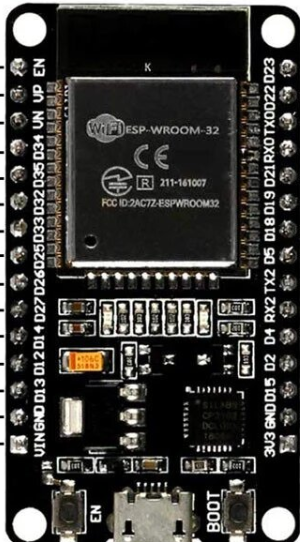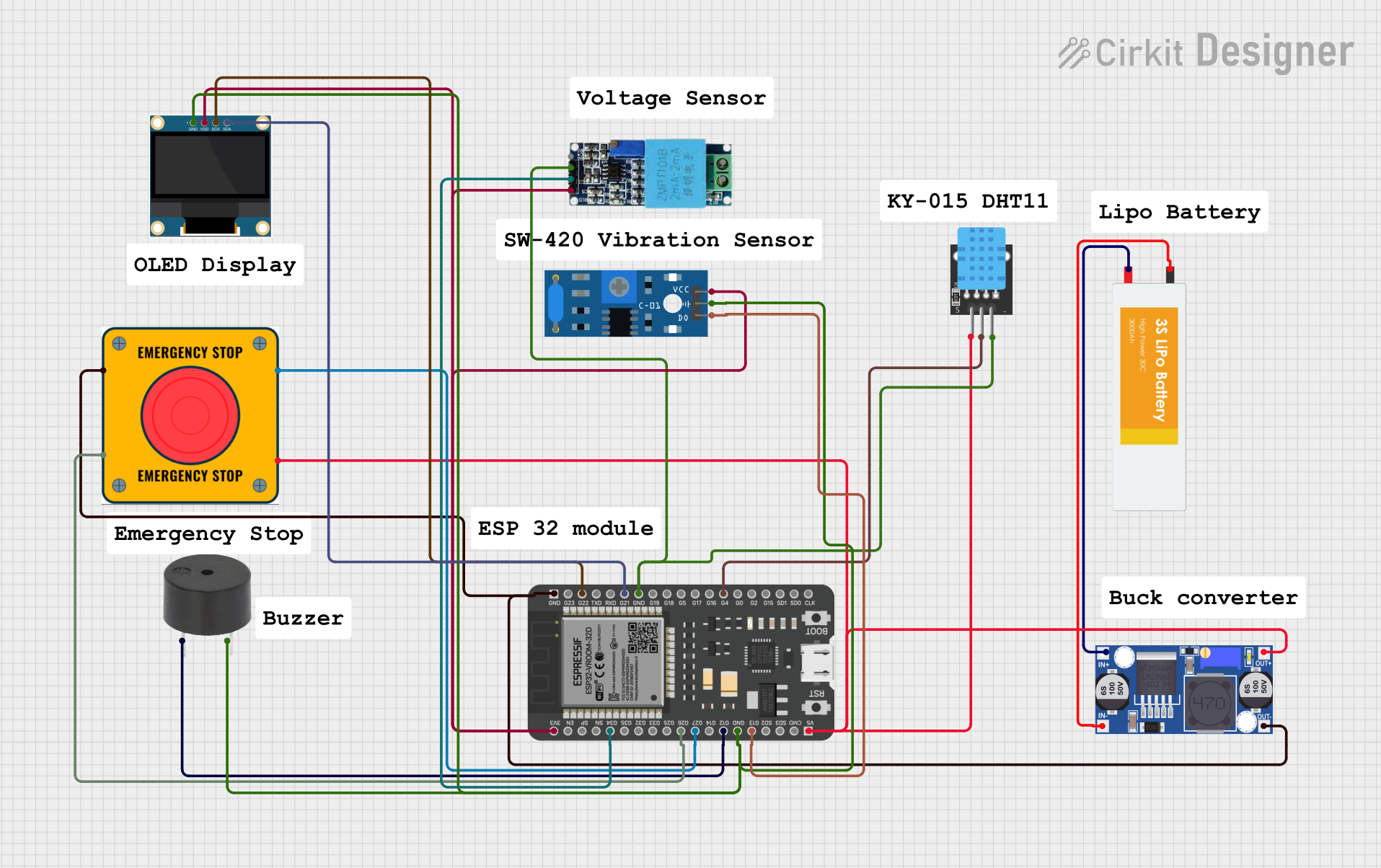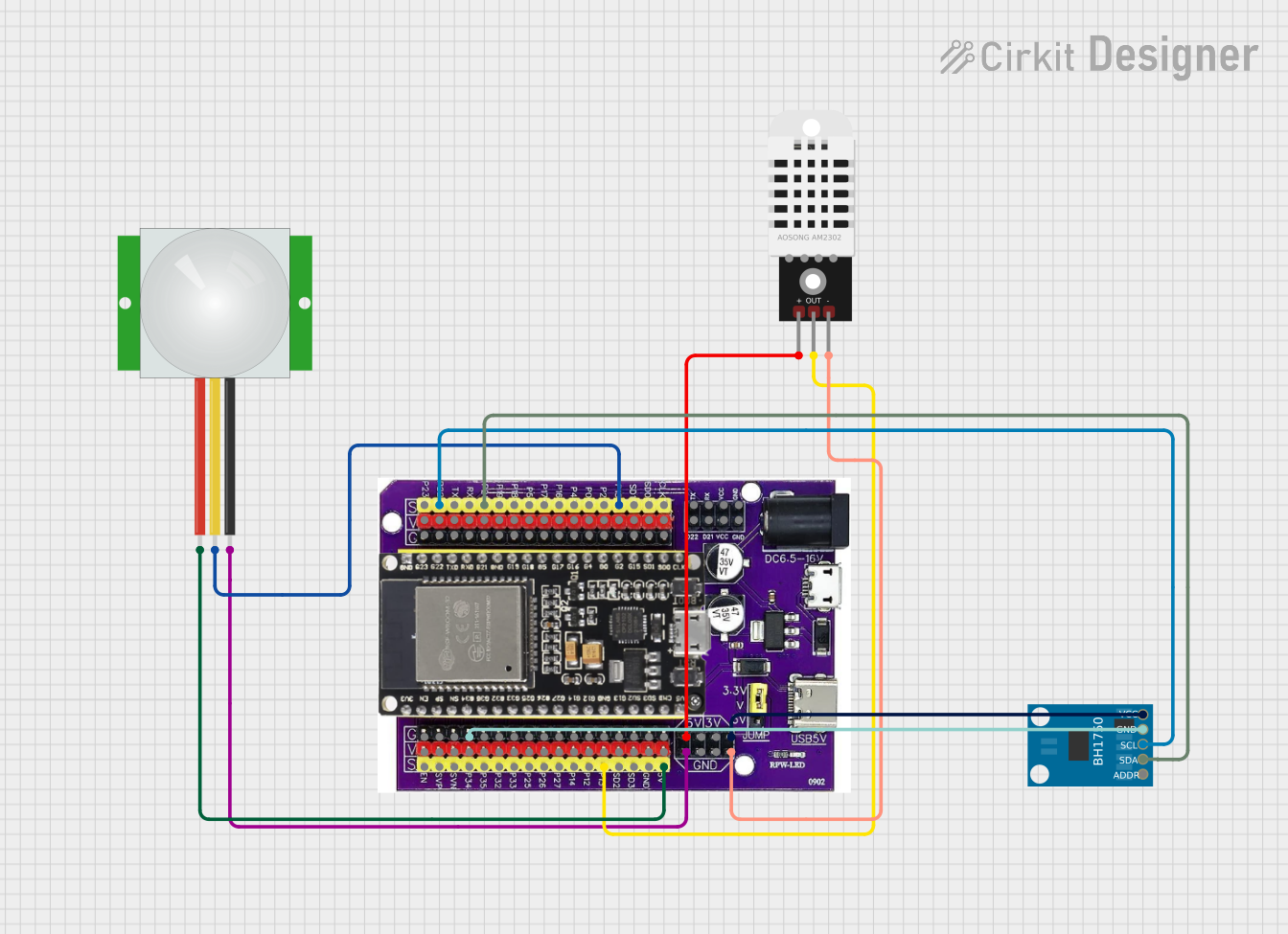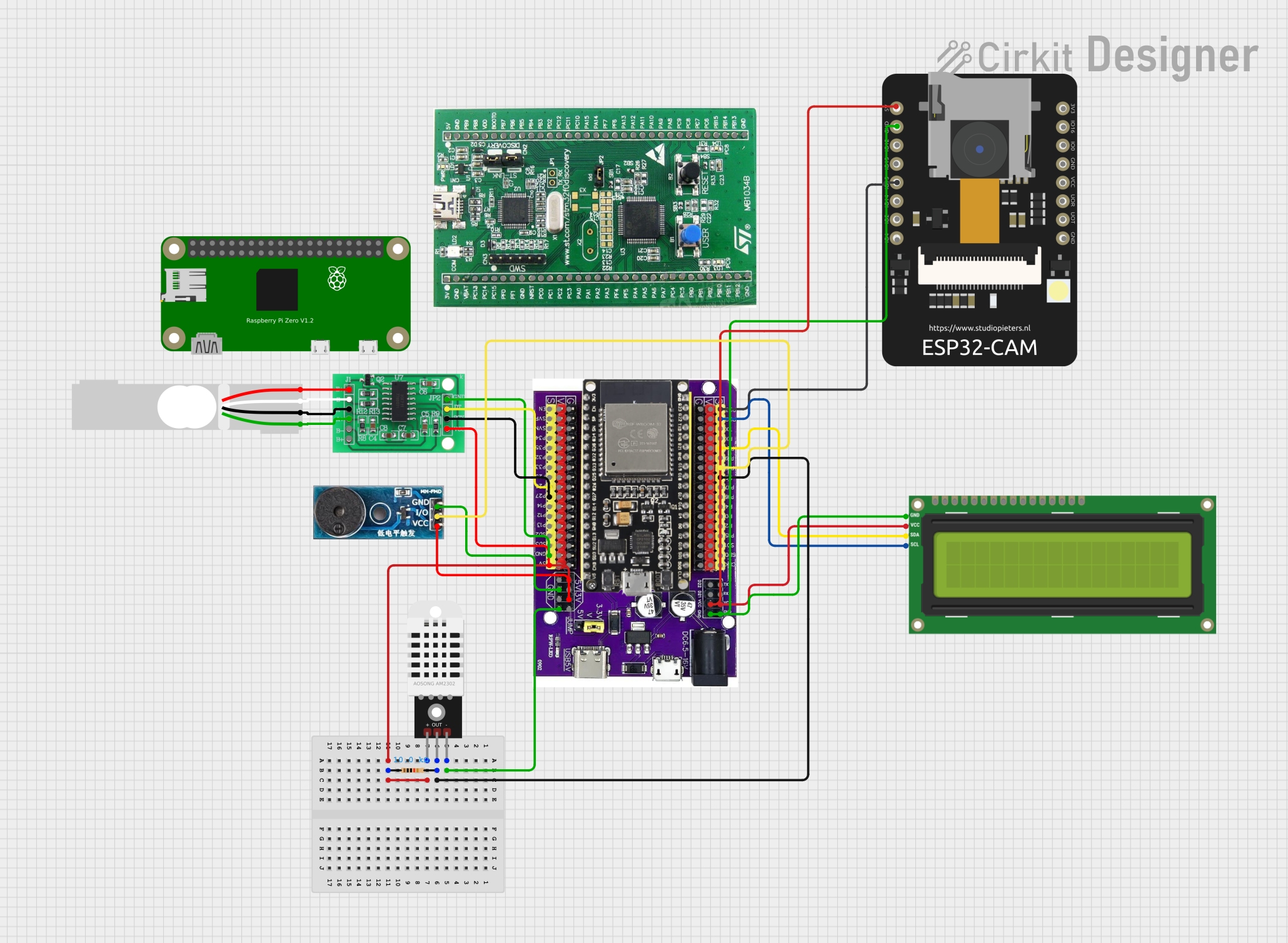
How to Use esp32: Examples, Pinouts, and Specs

 Design with esp32 in Cirkit Designer
Design with esp32 in Cirkit DesignerIntroduction
The ESP32, manufactured by Espressif Systems, is a low-cost, low-power system on a chip (SoC) with integrated Wi-Fi and Bluetooth capabilities. It is widely used in Internet of Things (IoT) applications, embedded systems, and smart devices. The ESP32 Dev Module is a development board that simplifies prototyping and development with the ESP32 chip.
Explore Projects Built with esp32

 Open Project in Cirkit Designer
Open Project in Cirkit Designer
 Open Project in Cirkit Designer
Open Project in Cirkit Designer
 Open Project in Cirkit Designer
Open Project in Cirkit Designer
 Open Project in Cirkit Designer
Open Project in Cirkit DesignerExplore Projects Built with esp32

 Open Project in Cirkit Designer
Open Project in Cirkit Designer
 Open Project in Cirkit Designer
Open Project in Cirkit Designer
 Open Project in Cirkit Designer
Open Project in Cirkit Designer
 Open Project in Cirkit Designer
Open Project in Cirkit DesignerCommon Applications and Use Cases
- IoT devices and smart home automation
- Wireless sensor networks
- Wearable electronics
- Industrial automation
- Robotics and drones
- Audio streaming and Bluetooth applications
Technical Specifications
Key Technical Details
- Manufacturer: Espressif Systems
- Part ID: ESP32 Dev Module
- Processor: Dual-core Xtensa® 32-bit LX6 microprocessor
- Clock Speed: Up to 240 MHz
- Flash Memory: 4 MB (varies by module)
- SRAM: 520 KB
- Connectivity: Wi-Fi (802.11 b/g/n), Bluetooth 4.2 (Classic and BLE)
- Operating Voltage: 3.3V
- I/O Voltage: 3.3V (not 5V tolerant)
- GPIO Pins: 34 (multiplexed for various functions)
- ADC Channels: 18 (12-bit resolution)
- DAC Channels: 2 (8-bit resolution)
- PWM Channels: 16
- Communication Protocols: UART, SPI, I2C, I2S, CAN, Ethernet MAC
- Power Consumption: Ultra-low power modes available (as low as 5 µA in deep sleep)
- Operating Temperature: -40°C to +85°C
Pin Configuration and Descriptions
The ESP32 Dev Module has a variety of pins for different functionalities. Below is a summary of the key pins:
| Pin Name | Function | Description |
|---|---|---|
| GPIO0 | Input/Output, Boot Mode Select | Used for boot mode selection during startup. |
| GPIO2 | Input/Output, ADC, DAC | General-purpose pin, can also function as ADC or DAC. |
| GPIO12 | Input/Output, ADC | General-purpose pin, supports ADC functionality. |
| GPIO13 | Input/Output, ADC, Touch Sensor | General-purpose pin, supports ADC and touch sensing. |
| GPIO15 | Input/Output, ADC, PWM | General-purpose pin, supports ADC and PWM. |
| EN | Enable | Active-high pin to enable or reset the chip. |
| 3V3 | Power | 3.3V power supply input/output. |
| GND | Ground | Ground connection. |
| TX0 (GPIO1) | UART Transmit | UART0 transmit pin for serial communication. |
| RX0 (GPIO3) | UART Receive | UART0 receive pin for serial communication. |
Note: Some GPIO pins are reserved for internal functions or have specific boot mode requirements. Refer to the ESP32 datasheet for detailed pin behavior.
Usage Instructions
How to Use the ESP32 in a Circuit
Powering the ESP32:
- Provide a stable 3.3V power supply to the
3V3pin. - Connect the
GNDpin to the ground of your circuit. - Avoid applying 5V directly to any GPIO pin, as the ESP32 operates at 3.3V logic levels.
- Provide a stable 3.3V power supply to the
Programming the ESP32:
- Use a USB-to-serial adapter (built into most ESP32 Dev Modules) to connect the board to your computer.
- Install the ESP32 board package in the Arduino IDE or use the Espressif IDF (IoT Development Framework) for advanced development.
Connecting Peripherals:
- Use GPIO pins for digital input/output, ADC for analog input, and DAC for analog output.
- Connect sensors, actuators, or other devices to the appropriate pins, ensuring voltage compatibility.
Uploading Code:
- Select the correct board and COM port in the Arduino IDE.
- Write or load your code, then click the upload button.
- Press the
EN(enable) button on the ESP32 board if required to reset the chip.
Example Code for Arduino IDE
Below is an example of how to blink an LED connected to GPIO2:
// Define the GPIO pin for the LED
#define LED_PIN 2
void setup() {
// Set the LED pin as an output
pinMode(LED_PIN, OUTPUT);
}
void loop() {
// Turn the LED on
digitalWrite(LED_PIN, HIGH);
delay(1000); // Wait for 1 second
// Turn the LED off
digitalWrite(LED_PIN, LOW);
delay(1000); // Wait for 1 second
}
Important Considerations and Best Practices
- Voltage Levels: Ensure all connected devices operate at 3.3V logic levels. Use level shifters if interfacing with 5V devices.
- Boot Mode: Avoid pulling GPIO0, GPIO2, or GPIO15 to incorrect states during boot, as this may prevent the ESP32 from starting properly.
- Power Supply: Use a stable power source to avoid unexpected resets or malfunctions.
Troubleshooting and FAQs
Common Issues and Solutions
ESP32 Not Detected by Computer:
- Ensure the USB cable is functional and supports data transfer.
- Install the correct USB-to-serial driver for your operating system.
Code Upload Fails:
- Check the selected board and COM port in the Arduino IDE.
- Press and hold the
BOOTbutton on the ESP32 while uploading the code.
Wi-Fi Connection Issues:
- Verify the SSID and password in your code.
- Ensure the Wi-Fi network is within range and not using unsupported security protocols.
Random Resets or Instability:
- Check the power supply for voltage drops or noise.
- Avoid using GPIO pins reserved for internal functions.
FAQs
Q: Can the ESP32 operate on 5V?
A: No, the ESP32 operates at 3.3V. Applying 5V to GPIO pins can damage the chip.
Q: How do I put the ESP32 into deep sleep mode?
A: Use the esp_deep_sleep_start() function in your code. Refer to the Espressif documentation for detailed instructions.
Q: Can I use the ESP32 with Bluetooth and Wi-Fi simultaneously?
A: Yes, the ESP32 supports simultaneous use of Bluetooth and Wi-Fi, but performance may vary depending on the application.
Q: What is the maximum range of the ESP32's Wi-Fi?
A: The range depends on environmental factors but typically extends up to 100 meters in open spaces.
This concludes the documentation for the ESP32 Dev Module. For more advanced features and examples, refer to the official Espressif documentation.